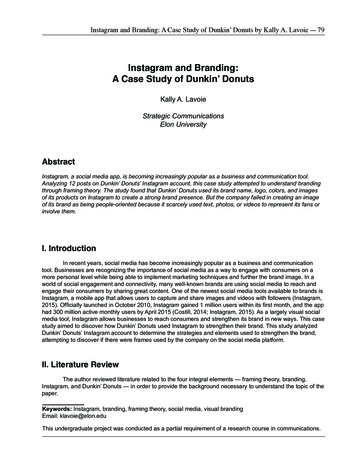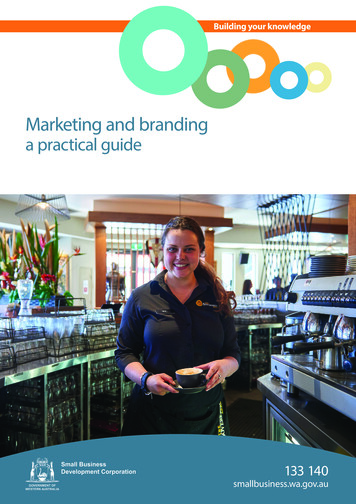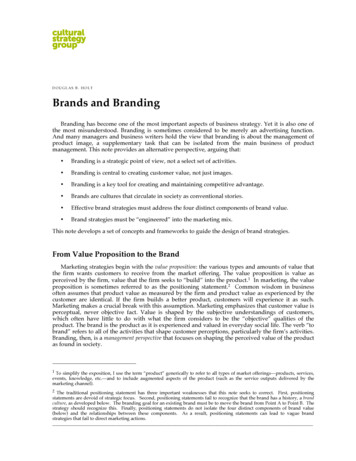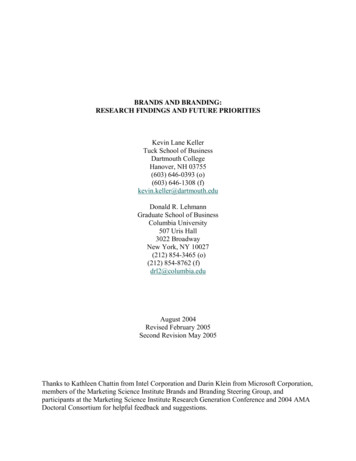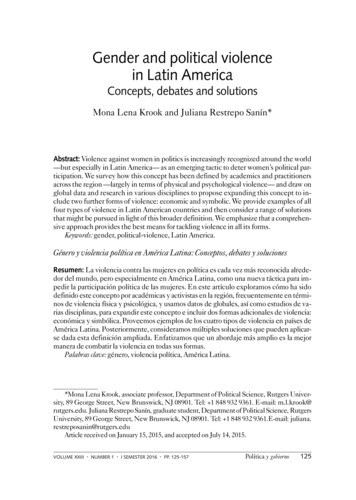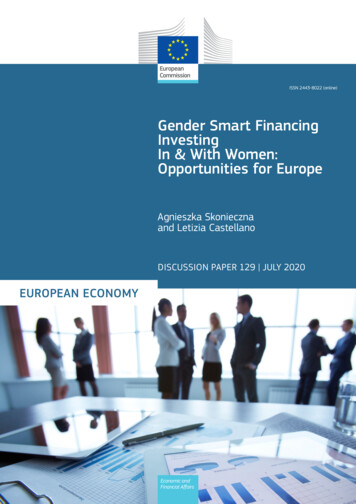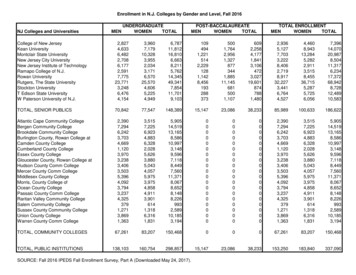
Transcription
Karlstad UniversityBerntson, AnnieJarnemo, ChristinaPhilipson, MinnaBranding and Gender- How adidas communicate gender valuesBusiness administrationMaster’s ThesisTerm:Supervisor:Karlstads universitet 651 88 KarlstadTfn 054-700 10 00 Fax 054-700 14 60Information@kau.se www.kau.seSpring 2006Patrik Gottfridsson
ForewordFOREWORDWe would like to thank the people who have contributed with support during the writingof our thesis.A special thank to our supervisor Patrik Gottfridsson and also Ulrika Jansson, for theirstimulating insights and discussions that have enriched our thesis.We should also like to thank our respondents Pernilla Molander, Jonas Carlström fromadidas, and also Janne Svensson at Clara advertising agency for their input of valuableinformation and material.Finally, our thanks to everyone who had to endure our weekends of toil.We wish you all pleasant reading!Karlstad, 2006Annie BerntsonChristina JarnemoMinna Philipson
AbstractABSTRACTThis thesis discusses how adidas differentiate their communication to reach women andmake the adidas brand more appealing to females. The adidas brand has always had theirmain focus on sportswear for men. This has led to the brand being perceived as masculineand it makes it hard for the female consumer to identify with adidas. We have analysedsix adidas adverts from the last five years to see what adidas have communicated towomen. The main purpose of this thesis is to understand why adidas have not succeededin communicating with women in the last five years.The theoretical chapter is divided into three parts; Brands, Communication and ConsumerBehaviour. The first part describes what a brand is, how it is built and continues with howa brand can be gendered. A brand is not very likely to keep a strong position if the valuesconnected with the brand are not reinforced through communication. When forming acommunication strategy, companies have to understand how consumers behave. Whenselling a gendered product, companies have to understand the distinction between menand women and how they differ in consumption.Our discussion is based on the qualitative method of collecting data. The qualitativemethod was carried out through two panel interviews and one personal interview, and wealso performed picture analysis on adidas’ advertisements. Ten open-individualinterviews with ten different women were conducted; to get their opinions on the sixadverts.Adidas have presented five different identities over five years, each with diverse focusand with different brand associations. This has led to a lack of consistency and thereinlies a part of the reason why adidas have not been successful in appealing to women.Since 2005 adidas have a collaboration with Stella McCartney. This is an attempt to adddesign to adidas functional clothes and to make their brand more appealing to women.This collaboration will continue until 2010 and this could provide adidas with theuniformity they need.
Table of contentsTABLE OF CONTENTSFOREWORD . 1ABSTRACT . 3TABLE OF CONTENTS . 41. INTRODUCTION. 61.1 Problem background . 61.2 Problem . 71.3 Delimitation. 81.4 Disposition . 82. ADIDAS. 92.1 Company history . 92.2 Adidas today. 102.3 Company segments . 103. THEORY. 123.1 Brands . 123.1.2 What is a brand? . 133.1.3 Building and managing a brand. 133.1.4 Gendering a brand . 143.2 Communication . 163.2.1 Advertising . 163.2.2 Sponsoring. 183.3 Consumer behaviour . 183.3.1 Gender in consumer behaviour . 193.3.2 Contemporary gender roles . 204. METHOD. 234.1. Choice of method . 234.2 Collection of information . 244.3 Photo and advertising interpretation . 254.3.1 Analytical tools. 265. EMPIRICAL CONTEXT. 285.1 Brands . 285.2 Communication . 295.2.1 Adidas by Stella McCartney. 315.3 Consumer behaviour . 316. PICTURE ANALYSIS . 336.1 Picture 1: . 34
Table of contents6.2 Picture 2: . 366.3 Picture 3: . 386.4 Picture 4: . 396.5 Picture 5. 416.6 Picture 6: . 437. DISCUSSION AND CONCLUSION. 457.1 Conclusion. 49REFERENCES. 51APPENDIXAppendix 1Interview with Pernilla Molander, Lifestyle Communication Manager, adidasAppendix 2Interview with Jonas Carlström, Sports Marketing Manager, adidasAppendix 3Interview with Janne Svensson, Project leader, Clara advertising agencAppendix 4Sports Marketing Sweden 20065
Introduction1. INTRODUCTIONThis first chapter begins with problem background and continues with our posedproblem. This is followed by our chosen delimitations and the disposition of the thesiscompletes the chapter.1.1 Problem backgroundBrands have become increasingly important for companies. A strong brand is aninvaluable advantage for a company, and can be seen as an eternal asset. It is one of themost effective ways to compete in a market (Holger & Holmberg, 2002). AccordingRooney (1995) brands have the ability to distinguish one company from another. Brandsare important to companies since they have the ability to bring certain attributes andassociations to a consumer’s mind and add value to the producer and the product. (Kotler,2003) Strong values connected to a brand, makes the brand stay in the consumer’sawareness and gain commercial power (Nilson, 2000). A problem that can occur is whena brand has many different products is that they try to tie a wide variety of values to thebrand. Too many values can confuse the consumer and result in a lack of identity,especially if the values are contradicting each other (Keller, 2003).An example of such a brand is Adidas that has, apart from a difficult patch in the 1980’s,been strong and successful in the sport industry ever since the 1950’s. Adidas coversmany spectrums of the sport and lifestyle markets. They have three different brandcategories, adidas Sport Performance, adidas Sport Heritage and adidas Sport Style. Thetwo latter are lifestyle, fashion and street wear collections and the former is the mostknown, the actual sportswear lines. Our focus is on Sports Performance; this brandcategory includes sportswear for five different sport segments, football, running,basketball, tennis and training. This brand category (Sports Performance) includes allsports equipment that adidas sell, both for professional athletes and regular peopleexercising. This poses a problem since it makes it hard for adidas to fully communicateand add values to all segments. If the communication is directed only to certain segmentsthen the consumer is likely to associate the brand with only these segments. Gender canenable companies to differentiate their brand from their competition and through thisachieve brand equity. To gender a new brand requires only minor modifications in thephysical attributes of the goods rather than advanced changes in the production process.In some cases it can be done just by changing the gender association of the packaging,advertising and sales promotion. (Alreck, 1994) Adidas is mainly associated withfootball, and is first and foremost known to be a sport for men (Molander, interview).Women have not been a priority communication-wise, which has resulted in the lack offeminine values associated with adidas.In our modern society many women are just as involved in sports as men are, and thefemale sportswear market is growing rapidly. The different gender roles and stereotypeshave gone through dramatically changes since the 1970’s. (Alreck, 1994) These changes
Introductionhas led to that women nowadays have a greater access to, and involvement, in organizedsports (Costa, 1994). There is also a new trend in consumer behaviour and women aregetting a bigger influence in all buying decisions and more and more companies realizethis and redirect their advertising towards women. This, as well as their increased interestfor sports, should make women an obvious target for adidas and their advertising.(Svensson, interview) Women are responsible for about 80% of individual consumerspending (Cohan, 2003) and they can therefore no longer be ignored by a brand of adidassize. If adidas wants to attract women to buy their products they have to make sure thattheir brand is appealing to women as well.An already existing brand can be harder to gender since the consumer might havepreconceived notions. Therefore the customer needs to be convinced and learn to connectcertain values with the brand and even change already set values. Communication andadvertising have the power to create associations with a brand and make the brand moreinteresting to the consumer (Nilsson, 2000). Women are more susceptible to advertisingthan men are and this makes advertising an excellent tool when trying to change thevalues of a brand. What women want and find attractive have changed enormouslyduring the last decades. To reach out to women and to achieve success, adidas have tounderstand these changes and follow the market development so that theircommunication can be adapted to the “modern” woman (Alreck, 1994).1.2 ProblemAs mentioned in the problem background, Adidas is a brand that covers many sports,many segments and several markets. This makes it hard for adidas to fully communicate,and add values to all segments. Women are becoming an increasingly influential targetgroup and they can therefore no longer be ignored by a brand, of adidas size. Our aim isto answer the main question:Why have adidas not succeeded with their communication towards women in thelast five years?We also intend to answer the following questions:How do adidas form their communication to reach women and make the adidasbrand appealing to females?What message are they trying to convey, who is the typical adidas woman?7
Introduction1.3 DelimitationWe have delimit
gain insight in their wants and needs. This strategy led to that Adidas at an early stage earned a reputation for being innovative and creative (Aaker and Joachimstaler, 2000). The big breakthrough for Adi Dassler and Adidas came when the German football team won the World Cup in 1954 with the new technology screw-in-studs (www.adidas.com).

